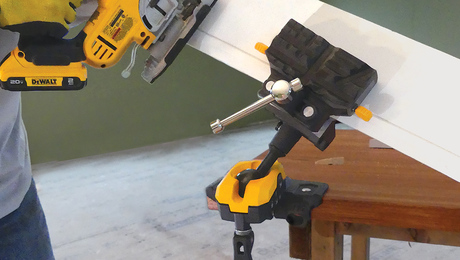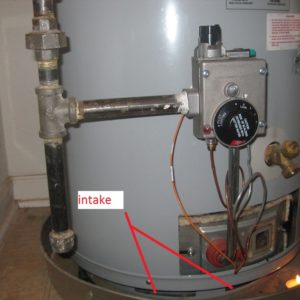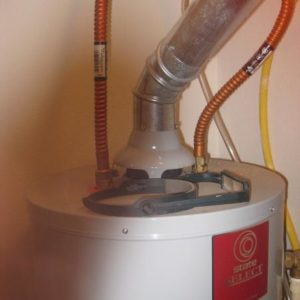I thought I would post this so someone else can benefit from the experience. We have a two story house with a gas water heater whose pilot light goes out randomly. This is a two story house, built in 2005. The water heater is on the second floor in a closet with the gas furnace. The house is in Charlotte NC so it also has whole house AC. The water heater has a closed combustion chamber with an air intake on the bottom. The closet is adequately vented to the rest of the house. The water heater and furnace vent to a common flue out thru the roof. So far I have – cleaned the intake filter and the screen filter at the bottom of the combustion chamber – changed the pilot and thermo couple – called a plumber who was no help – changed the gas valve – the water heater manufacturer sent me a new valve, so why not. – checked to make sure the flue was not clogged. It was free and clear with a good cap on the top. – added another intake vent to the room after running it with the door open for a couple of days. – Checked the flue temperature, thinking that a cold draft was coming down the flue and extinguishing the pilot. The flue was not cold – outside temp about 45. The water heater and the gas furnance share a common 6″ flue via a Y junction. – Checked the drip leg on the gas line. The manual says it should be more than 3″ long. It was 4″. – Checked for a drip tee by the gas meter. Did not have one. – Ran the furnace, the dryer and all the bath fans. The pilot light was unaffected. – Made sure the pilot flame was blue and covering the thermocouple. It was. – Watched the burner light to see if it blew out the pilot. It did not after several tries. – Checked the main gas valve, it was all the way on. – I removed the burner and felt the flue inside the water heater. It was damp. With the burner running and cold water at the bottom of the tank, I could hear drops of water falling on the burner. After talking to tech support, they suggested that condensation from the combustion products was dripping on the pilot and extinguishing it. The solution was to rotate the the internal baffle a quarter turn. Paul Chek www.HeritageHomeRestoration.com
Discussion Forum
Discussion Forum
Up Next
Video Shorts
Featured Story

The IQ Vise has angled jaws, a simple locking mechanism, and solid holding power.
Highlights
"I have learned so much thanks to the searchable articles on the FHB website. I can confidently say that I expect to be a life-long subscriber." - M.K.
Fine Homebuilding Magazine
- Home Group
- Antique Trader
- Arts & Crafts Homes
- Bank Note Reporter
- Cabin Life
- Cuisine at Home
- Fine Gardening
- Fine Woodworking
- Green Building Advisor
- Garden Gate
- Horticulture
- Keep Craft Alive
- Log Home Living
- Military Trader/Vehicles
- Numismatic News
- Numismaster
- Old Cars Weekly
- Old House Journal
- Period Homes
- Popular Woodworking
- Script
- ShopNotes
- Sports Collectors Digest
- Threads
- Timber Home Living
- Traditional Building
- Woodsmith
- World Coin News
- Writer's Digest




















Replies
Had a standing pilot gas furnace where the pilot would go out randomly. After observing it for several months I figured out that the failing scenario was that the unit would begin to fire with a cold flue and "whoosh" that was produced would blow the pilot out. After trying several things to fix it, I finally called the factory, an an old geezer on the service line advised that I adjust the pilot light pressure DOWN -- he said that too much pilot pressure caused the flame to "stand off" of the pilot burner and make it easier to blow out.
I tried that adjustment and it worked! Rock solid after that.
Update 12/29/2009
Talked to my renters and the pilot is still going out usually after someone takes a shower.
Thanks Dan, I will ask the factory about the gas pressure adjustment.
Mr. Lots of Numbers,
You didn't note at the beginning that this was a rental property. All bets are off in that circumstance, as there's no telling what the tenants might be doing, and we couldn't possibly guess. Please confine future postings to your own house. Thanks.
"Please confine future postings to your own house. Thanks."
What? Do you have something against owners of income property? And who, exactly, appointed you arbiter of what questions are suitable for the forum? Would the OP have been in violation of your rules of posting if it were his granny's house instead of his own?
I'm with bruce - there id
I'm with bruce - there id absolutely nothing to suggest that questions here should be restricted and exclude questions about rental property.
FWIW, I've learned some pretty good stuff from the answers in this thread.
"added another intake vent to the room after running it with the door open for a couple of days."
Did leaving the door open help? If it did, then it's possible that when the furnace blower runs, there are poorly-sealed return runs that can de-pressurize the furnace room. I've seen this many, many times, especially in homes that have the ductwork enclosed in furr-downs and chases--the return leaks effectively turn the chases into a vacuum tube that sucks air from the furnace room.
You can easily test for this: while the furnace is running, step inside the furnace room and close the door. Then feel along the bottom of the door to see if air is rushing into the furnace room.
If it is, there is a good chance the water heater flue is backdrafting at times, and this can cause the pilot light to fail, especially if the flame tends to stand off, as Dan mentioned. But worse still, the backdrafting can send CO into the house.
I did not see reference in your long list of troubleshooting steps to wind conditions. Is it possible that the times when the pilot goes out are associated with windy weather that might send a gust back down the flue?
>>Is it possible that the times when the pilot goes out are associated with windy weather that might send a gust back down the flue?
That is what the gap between the top of the water heater and the bottom of the flue (called the drafthood by some) prevents.
On a good day.
Have you ever seen one that didn't "work?"
Gust of wind or whatever 'shoots' down the flue, reaches the 1 1/2" to 2" gap of the drafthood and the column of blowing air jumps the gap continues down the inner tank flue (which will likely have some minor but very real stack effect from the pilot light?)
In a hurricane, maybe {G}
And yes, I've seen backdrafting flues (some pretty vigorous) on furnaces and water heaters, but I've never seen the back drafting jump the drafthood gap.
I've seen my draft gauge "reverse" in a water heater flue when a furnace kicked on in an enclosed space, causing the water heater flue to back draft, but the times I've checked, the warmish air rising through the internal flue has continued to rise.
IIRC, the standard for testing is a 60 mph wind blowing across a chimney shall not affect the draft.
Update 12/30/2009
Spent another 3 hours with the water heater and actually saw the pilot go out.
Ran the hot water for 5 minutes in a bath and a sink - shower simulation. The water heater burner came on and ran for 25 to 30 minutes. When the burner shut off the pilot went out. Recorded the whole thing with a video camera.
Tried the same test, but this time ran the hot water for only 1 minute. The WH burner ran for 12-15 minutes but this time when the burner shut off the pilot stayed lit.
Repeated the 5 minute test and the pilot went out.
Talked to tech support at State and they thought the burner area was over heating and the diode on the thermocouple was actually tripping and shutting off the gas to the burner and pilot. They suggested cleaning the spark arrester screen and intake air area which was already done.
Just for good measure I also redid the flue so I had a 12" vertical rise on top of the draft hood.
Thanks for the follow-up on this. For me, at least, this a new one.
>> the burner area was over heating and the diode on the thermocouple was actually tripping and shutting off the gas to the burner and pilot.
Huh? The thermocouple detects the absence of heat from the pilot and shuts off the flow of heat to the pilot if it gets too cool (i..e, the pilot is out.)
They're saying the thermocouple is getting too hot?
And shutting off the flow of gas to the Burner? (As well as to the pilot????)
Did the pilot go out the very second the burner shut down? Or was there a minute to several second delay?
Clean the thermocouple contacts.
Update 1/5/2010
The thermo couple for this water heater has the FVIR sensor in line with the thermocouple. When the sensor gets too hot it trips and shut off the gas. When the burner and the pilot went out they both went out at exactly the same time.
Ran a little test on the original thermocouple that I previously replaced. I measured the resistance on the diode / sensor when it was cold. Then using a heat gun I heated the sensor and watched the resistance slowly increase. When the temperature on the sensor hit 140 it "tripped" and resistance increased to infinity.
So when the temperature in the burner area hits 140 the burner and the pilot goes out. This corresponds to the results of the the 5 minute test.
Bottom line: throw out the State heater and replace it with a Bradford White.
So this "sensor" is some distance from the pilot flame? What is it really measuring the temperature of? Certainly the temp within a few inches of the burner is over 140F.
Dan, it is measuring the temp of the burner chamber. Combustion air, which is room temp enters the bottom, and keeps the bottom of the burner chamber "cool".
If the screens become blocked,the venting gets blocked, or a flammable vapor ignites in the chamber, the temp rises and the sensor trips. Basically a snap disc high limit.
Some makers use a manual reset snap disc on the burner door.
Easy to trouble shoot, but also easy to bypass.
Others use a chemical sensor. Paint your floor with an oil base paint while the heater is running and you buy a new sensor.
Screens can get plugged with lint, cat hair, etc, or from rust from the tank. We have a vet in town that uses a 40 gal tank to wash down stalls and pens. They always run out of hot water which leads to condensation and rust, and service call from us about once a year to clean the screens.
Interesting stuff.
Do you have a theory as to why the sensor was overheating?
You mentioned earlier that you had cleaned the screen, so I wonder how the the sensor was overheating?
This might be beating a dead horse, but I can't help wondering (again) if the closet or enclosure that contains the WH and furnace was being de-pressurized by faulty ductwork, so that when the door to the furnace room was closed, there would not be sufficient airflow to the burner chamber, thereby causing the sensor to overheat. ???
OTOH, I suppose that, during the times when you were watching the burner and pilot, you probalbly had the door open all the time--if so, that eliminates my theory about de-pressurization.
Any ideas of your own?
One more possibility:
Could the WH have been over-fired?
If you live at a high elevation, like 4000 ft or more, the lower density of the air means that gas appliances should be de-rated for their input. (smaller orifice)
Over-firing can also be caused by too-high gas pressure.
I checked the depressurization theory today - furnace on door closed. No air was rushing under the door. One of the early things I did was to add a third vent to the closet.
The sensor is about 2" from the thermocouple. I agree with Rich that the sensor's job is to measure the temp of the combustion chamber and the sensor "thinks" the chamber is too hot.
Since I already blew out the screen - which is only about 5" in diameter - and cleaned the external lint filter and changed the thermocouple; I am guessing that the original owner had problems with the water heater too. The screen could still be clogged in some way, but it cannot be removed.
So go with a new WH. The screen in the Bradford White is 18" in diameter, the sensor is about 9" from the burner and has a push button reset. The WH arrives Friday!
Has to the "over fired" comment. We are in Charlotte NC, well below 4000'. We did have the gas company out to check the pressure and they said it was right where it was supposed to be.